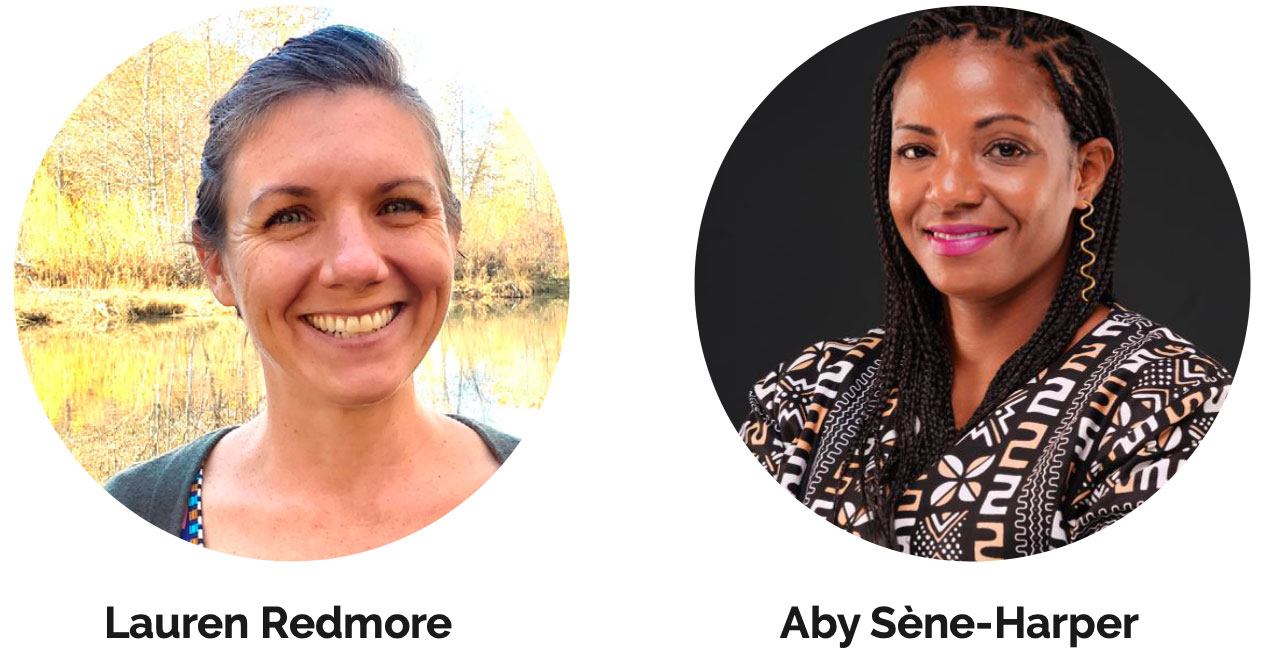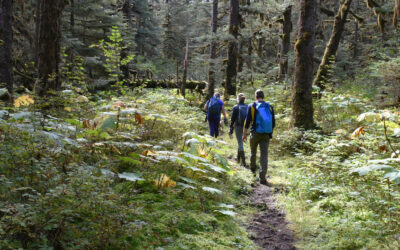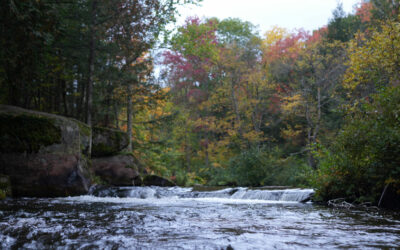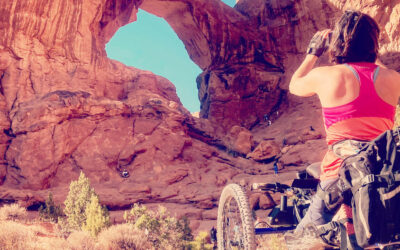Running through the trees. Photo credit: Jed Villejo on Unsplash.
Reflections on Wilderness 60 Years after the Civil Rights and Wilderness Acts
by LAUREN REDMORE and ABY SÈNE- HARPER, SPECIAL ISSUE GUEST EDITORS
Editorial Perspectives
December 2023 | Volume 29, Number 2

The American Wilderness Myth?
America’s dominant narrative of the origin of a beloved wilderness often centers Aldo Leopold in a heroic fight at the turn of the century against rapid industrialization that occurred at the expense of nature. Wild spaces, so the story goes, needed preservation from and for the people, so that future generations would know what it means to be self-reliant in pristine nature far away from civilization (Nash 2014). These future generations could experience a re-creation of the ancient human connection to nature. In this story, wilderness is at once a safeguard for the environment and wild beings, and an escape for modern humans from the ills of industrial society (Rashkow 2014; Cronon 1996).
Yet wilderness is more than an ideology and more than a practice of conservation and environmentalism. Throughout the history of the United States, wilderness has been entangled with both oppressive forces and spaces of resistance (e.g., LaPier 2021; Davis 2019). In this way, wilderness is complex in that each individual and group has their own (often conflicting) value, meanings, and experiences with wilderness. It is also dynamic as individuals and groups are malleable and influenced by internal and external forces. To boil wilderness down to a singular thing, meaning, or experience can perpetuate ideologies that erase the experiences, cultures, and values of oppressed groups. Wilderness has never been and will never be a singular idea, story, value, or experience to all people.
Contested Ideas of Wilderness, Past and Present
Ideas of wilderness are grounded in starkly oppositional values pertaining to the landscapes and human–nature relations. For example, wild spaces have long embodied contestations between the White settler colonial regime and Black and Indigenous people (Sène-Harper, Mowatt, and Floyd 2022). Eurocentric ideals of wilderness situated wild lands as pristine sanctuaries unaltered by civilization (Nash 2014), though, as William Cronon pointed out, “Far from being the one place on earth that stands apart from humanity, it is quite profoundly a human creation…wilderness hides its unnaturalness behind a mask that is all the more beguiling because it seems so natural” (Cronon 1996, p. 7).
But long before Western scholars began to challenge assumptions about the naturalness of wilderness, Indigenous land and water protectors contested the wilderness ideology as they mounted resistance against their dispossession for the establishment of our national parks (The Wilderness Society 2022; Spence 1999). Through acts of resistance in wilderness, Black and Indigenous people reassert their belonging in spaces, preserve Indigenous ways of life, and maintain relationship with each other, the land, and their more-than-human kin (e.g., Estes 2019; Gilio-Whitaker 2019; Mar 2010).
Wilderness is inherent to colonial imaginaries about “taming the wilderness” that are central to the populist “frontier ideology” and legitimized the genocidal settler conquest by White nationalist interests (Dunbar-Ortiz 2018 p. 208). Today, media representations of America’s parks and protected areas continue to come with claims about these “more than scenic places” that “tell our story and show who we are” (National Geographic 2015). Yet these representations do not represent a unified truth given that Indigenous anticolonial fighters and Black liberationists and abolitionists rejected the nationalist landscape mythos that wilderness represented and the idea of a unified nation imposed upon them by White settlers (Opperman 2020; Sène-Harper, Mowatt, and Floyd 2022; Dunbar-Ortiz 2021). Instead, many long-underserved and oppressed Americans advance alternate visions of wilderness through “counter-geographies” or landscape imaginaries to define spaces for themselves and destabilize dominant and exclusionary representations (e.g., Madera 2015; Schmidt 2021).
Alternative Visions of Wilderness
While many counter-geographies of wilderness exist, we highlight two. In particular, Indigenous activists have long shared their own visions of wilderness that are as diverse as the languages spoken across Turtle Island prior to European arrival. For example, Chief Luther Standing Bear, chief of the Oglala Sioux in 1905, who later became an actor, shared that:
We [the Sioux] did not think of the great open plains, the beautiful rolling hills, and winding streams with tangled growth as “wild.” Only to the white man was nature a “wilderness” and only to him was the land “infested” with “wild” animals and “savage” people. To us it was tame. Earth was bountiful and we were surrounded with the blessings of the Great Mystery (Standing Bear 2006, p. 62).
Wilderness as a place free from people, in other words, did not exist because nature is inseparable from people. Yet as Europeans began to settle the Americas, they “discovered” a vast wilderness inhabited by a diversity of Indigenous peoples, both of which they believed were at once dangerous and also could be tamed for the growth of their wealth and empire (Nash 2014). Alongside enslavement of Indigenous Americans to begin the settlement project, Africans were captured and forced to endure grueling passage across the Atlantic toward generations of enslavement. Poor Europeans, too, desperate for a new life with opportunity signed away their rights in exchange for passage to the New World where they would serve for years as indentured servants (Morris 2022). All were seen as expendable bodies capable of transforming natural capital to wealth. Yet many indentured and enslaved people sought freedom in the impenetrable wildernesses, often in the lowland swamps across the East Coast. Historian J. Brent Morris described how escaped enslaved peoples of all races sought freedom from tyranny of plantation capitalism in the safety of the Great Dismal Swamp:
The wild Dismal Swamp was, put simply and literally, out of control. It was a physical reminder that for all the symmetry and precise angles of the world exterior to the swamp, the ideal ordered world of the Tidewater could never be fully achieved…. It was also becoming dangerous for the sanctuary it offered the equally untamed “dregs” of society who were, it seemed, settling together in the Dismal. White, Red, Black, and “tawny,” the swamp beckoned to them as an outlaw’s haven…. What made the marronage of these outcasts even more vexing to white elites was the notion that they had actively rejected “civilization,” embraced the wildness of the swamp, and regressed into barbarism, an animal state of nature (Morris 2022, p.45).
What if instead of romantic Anglosaxon ideals of wilderness as escape from civilization through recreation of “primitive” human conditions in pristine nature, we celebrated a Lakota vision of wilderness as inseparable from humanity? What if instead of the origin of wilderness as an antidote to industrialization, we heralded wilderness as places where diverse and oppressed peoples created collaborative spaces as an act of rebellion and freedom from tyranny? We might learn that wilderness is compatible with diverse cultures, perspectives, and legacies, and we might locate values within wilderness that connect us all on the path toward a freer and more just society.
Wilderness for a Diverse America on the Eve of the 60th Anniversary of Passage of the Wilderness Act and Landmark Civil Rights Laws
In choosing the theme of this special issue, Wilderness for a Diverse America, we anticipated many of the challenges associated with the fact that neither wilderness nor diversity are singular: neither can be defined succinctly, measured with certainty, or valued unanimously. The 88th Congress that passed the Wilderness Act in 1964 was far from representative of the American public – most members of Congress were white, able-bodied men – yet that Congress also passed landmark civil rights laws, including the Civil Rights Act of 1964, the Equal Pay Act, and more. As Lauret Savoy wrote 10 years ago on the 50th anniversary of the Wilderness Act and the Civil Rights Act,
Ending Jim Crow segregation and protecting wild land have more to do with each other than meets the eye…. Their energies converged two remarkable months apart in 1964 with two laws that redefined relations between citizens and the American land, in terms of rights and access for all versus restraints on where and how people could live with dignity (Savoy, 2014).
The strands of conservation and civil rights are entwined not only in past landmark legislation but also in our future as a nation and a global society. Now, on the eve of the 60th anniversary of the passage of both the Wilderness Act and the Civil Rights Act, we examine what wilderness means for a country in progress, where participation in society is constantly being renegotiated, from leadership and representation to legal rights and protections to who is visible in public spaces. In other words, as more Americans can participate more fully in society, this issue examines how the very connections to, interpretations of, and ways of relating with wilderness are subject to change.
We open this issue with perspectives from Amanda Grace Santos and other emerging land management professionals on what diversity, equity, inclusion, and access in wilderness means to them,
and an exclusive interview with Bryant Waupoose Jr., executive director of Medicine Fish, a nonprofit supporting Menominee youth through healing experiences on the Wild and Scenic Wolf River and beyond. Next, Brett Quin and Erin Drake share their work advancing wilderness accessibility for people with disabilities, and Kimm Fox-Middleton shares a creative solution toward getting early career land management professionals excited about sharing with and learning from a retiring wilderness work- force. Adrienne Lindholm shares the work of the National Park Service to reimagine a more inclusive wilderness concept using a case study of Glacier Bay National Park, Alaska, and Lauren Redmore and coauthors led an effort to understand what wilderness management professionals would like to see from an interagency toolbox for diversity, equity, and inclusion. Kelsey Phillips and Will Rice share findings from a scoping review to understand what the literature says about fairness and equity in US river recreation allocation systems, while Elena Thomas and coauthors share results from a study to examine underserved community member perspectives on wilderness character in Everglades National Park. This issue wraps up with two international contributions, including an exploration by Ezekiel Adesawe of what wilderness means in Yorùbá Culture, specifically in the Osun-Osogbo Sacred Grove. Rayna Benzeev, Diego Melo, and Devon Reynolds conclude this special issue with a movie review of National Geographic’s film The Territory, which shows how one Indigenous community, the Uru-eu-wau-wau, defend their claim to land through advanced technologies and asks us what role the Brazilian authorities should play in protecting Indigenous land rights.
The contributors to this special issue advance a wide range of ideas, findings, and efforts toward better understanding of what wilderness is and how it can be stewarded to respect and reflect diverse cultures, generations, abilities, and perspectives. Yet these contributions speak to just some of the many ways we can envision meanings and practices of Wilderness for a Diverse America. We believe that this special issue, the first of its kind for the International Journal of Wilderness, is a step in the right direction to locate that common ground, though more conversations and study are required to ensure wilderness is relevant and accessible to a diverse America.
Acknowledgments
This work was supported in part by the USDA Forest Service, Rocky Mountain Research Station, Aldo Leopold Wilderness Research Institute. The perspectives in this publication are those of the authors and should not be construed to represent any official USDA or US Government determination or policy.
About the Authors
LAUREN REDMORE is a research social scientist with the USDA Forest Service Aldo Leopold Wilderness Research Institute where she uses her training in environmental anthropology to better understand how to improve diversity, equity, and inclusion in wilderness and wildlands; email:lauren.redmore@usda.gov
ABY SÈNE-HARPER is an environmental social science researcher at Clemson University where she also serves as an assistant professor in Parks and Conservation Area Management. Her work seeks to inform policy development for social and ecologically just approaches to managing natural and cultural resources in the US and Africa; email:abyh@clemson.edu
References
Cronon, W. 1996. The trouble with wilderness: Or, getting back to the wrong nature. Environmental History 1(1): 7–28.
Davis, J. 2019. Black faces, black spaces: Rethinking African American underrepresentation in wildland spaces and outdoor recreation. Environment and Planning E: Nature and Space 2(1): 89–109.
Dunbar-Ortiz, R. 2021. Not “a Nation of Immigrants”: Settler Colonialism, White supremacy, and a History of Erasure and Exclusion. Boston: Beacon Press.
Dunbar-Ortiz, R. 2018. Loaded: A Disarming History of the Second Amendment. San Francisco: City Lights Books.
Estes, N. 2019. Our History Is the Future: Standing Rock versus the Dakota Access Pipeline, and the Long Tradition of Indigenous Resistance. New York: Verso Books.
Gilio-Whitaker, D. 2019. As Long as Grass Grows: The Indigenous Fight for Environmental Justice, from Colonization to Standing Rock. Boston: Beacon Press.
LaPier, R. 2021. Sustainable Missoula: Say goodbye to the words “wild” and “wilderness.” Missoula Current.
Madera, J. 2015. Black Atlas: Geography and Flow in Nineteenth-Century African AmericanLiterature. Durham, NC: Duke University Press.
Mar, T. B. 2010. Carving wilderness: Queensland’s national parks and the unsettling of emptied lands, 1890–1910. In Making Settler Colonial Space: Perspectives on Race, Place and Identity (pp. 73–94). London: Palgrave Macmillan UK.
Morris, J. B. 2022. Dismal Freedom: A History of the Maroons of the Great Dismal Swamp. Chapel Hill: University of North Carolina Press Books.
Nash, R. F. 2014. Wilderness and the American Mind. New Haven, CT: Yale University Press.
National Geographic. 2015, December 8. How national parks tell our story – and show us who we are. https://www. nationalgeographic.com/magazine/article/national-parks-centennial.
Opperman, R. 2020, August 3. We need histories of radical black ecology now. In Black Perspectives. African American Intellectual and History Society. https:// www.aaihs.org/we-need-histories-of-radical-black-ecology-now/.
Rashkow, E. D. 2014. Idealizing inhabited wilderness: A revision to the history of Indigenous peoples and national parks. History compass 12(10): 818–832.
Savoy, L. 2014. Wilderness and Civil Rights 50 years later: Recognizing the ties of race and place. Huffington Post. http://www.huffingtonpost.com/lauret-savoy/wilderness-and-civil-righ_b_5760902.html?1409770403.
Schmidt, J. 2021. (De)constructing nature and disability through place: Towards an eco-crip politic. Phd diss. Washington State University, Pullman, WA.
Sène-Harper, A., R. A. Mowatt, and M. F. Floyd. 2022. A people’s future of leisure studies: Political cultural black out- doors experiences. Journal of Park and Recreation Administration 40(1).
Spence, M. D. 1999. Dispossessing the Wilderness: Indian Removal and the Making of the National Parks. New York: Oxford University Press.
The Wilderness Society. 2022. Know the past, change the future: The public lands curriculum. https://www.wilder- ness.org/new-public-lands-curriculum.
Read Next
Removing the Wilderness Illusion: Emerging Professionals Explore Diversity, Equity, Inclusion, and Accessibility in Wilderness
From the eyes of four emerging professionals in land management come four different wilderness stories.
Medicine Fish Is Leading the Way to Heal, Build, and Inspire Menominee Youth through the Wild and Scenic Wolf River: An interview with Bryant Waupoose Jr., Founder of Medicine Fish
From a bird’s eye view, the Menominee Reservation is a forested oasis in sharp relief from neighboring landscapes of dairy farms spanning northeastern Wisconsin.
Wheelchairs in Wilderness: One User’s Perspective on Ways to Improve Wilderness Accessibility for All
Lately, I’ve had a strong desire to return to my favorite wilderness area and attempt the area’s rim-to-river trail.



